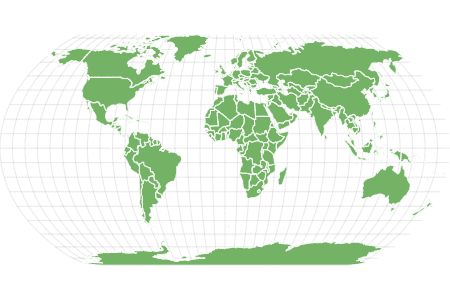Sardines
Schools of sardines can be miles long and are often visible from an airplane
Advertisement
Sardines Scientific Classification
Read our Complete Guide to Classification of Animals.
Sardines Conservation Status
Sardines Facts
- Main Prey
- Zooplankton and Phytoplankton
- Group Behavior
- School
- Fun Fact
- Schools of sardines can be miles long and are often visible from an airplane
- Estimated Population Size
- Pacific Sardine population is measured at 27,547 metric tons
- Biggest Threat
- Overfishing as a food source
- Most Distinctive Feature
- Silver color and one small dorsal fin
- Other Name(s)
- Pilchard, Sardina
- Gestation Period
- Eggs hatch in three days
- Habitat
- Saltwater oceans and seas around the world
- Predators
- Dolphins, seals, penguins, sharks, terns, pelicans
- Diet
- Omnivore
- Type
- Ray-finned fish (Actinopterygii)
- Common Name
- European Pilchard, Pacific Sardine, South American Pilchard
- Number Of Species
- 21
View all of the Sardines images!
Schools of sardines can be miles long and are often visible from an airplane.
Sardines are a group of herring fishes that encompass five distinct genera and at least 21 unique species. One of the most common sardines used in cooking and food preparation is the Pacific Sardine, also known as Sardinops caeruleus.
Sardines are small fish that typically do not exceed 12 inches in length and can weigh as little as three ounces each. However, some larger herring varieties, such as the American Shad, can reach as much as seven pounds in weight.
European fisheries refer to these fish as pilchards. In fact, the UK and other European nations define them as juvenile pilchards that are less than 6 to 12 inches in length. Other varieties include the South American Pilchard, the Bali Sardinella and the Indian Oil Sardine.
These fish all have silvery scales and one small dorsal fin. They swim in large schools that can stretch for miles. They are found in almost every area of the world including the Atlantic and Pacific Oceans, the Mediterranean Sea, the Dead Sea, the waters around Morocco and other nations.
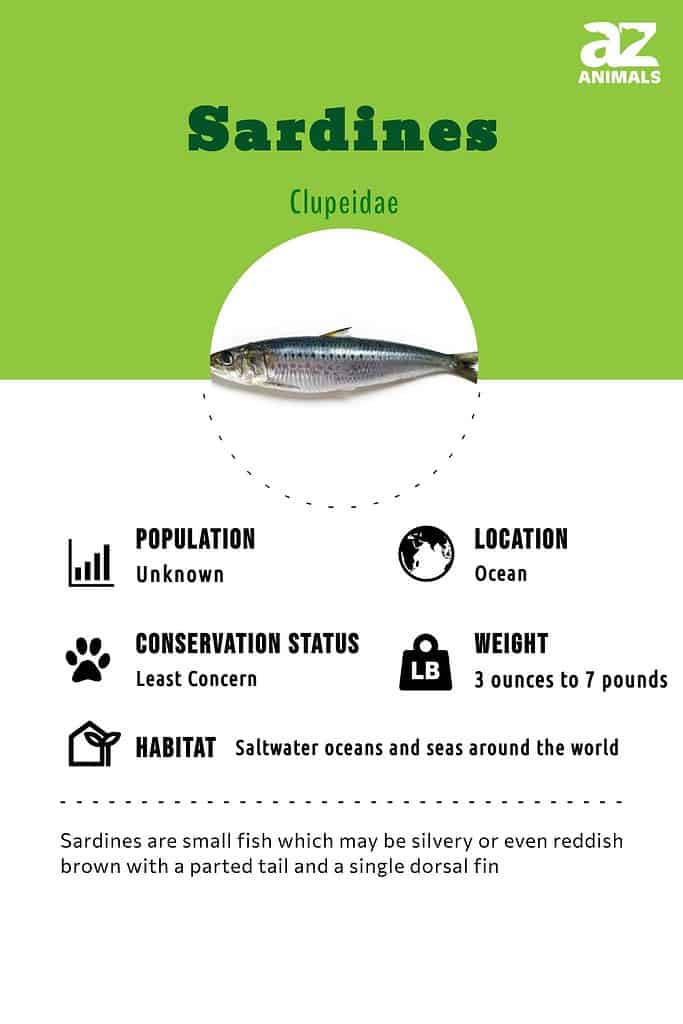
Sardines vs Anchovies?
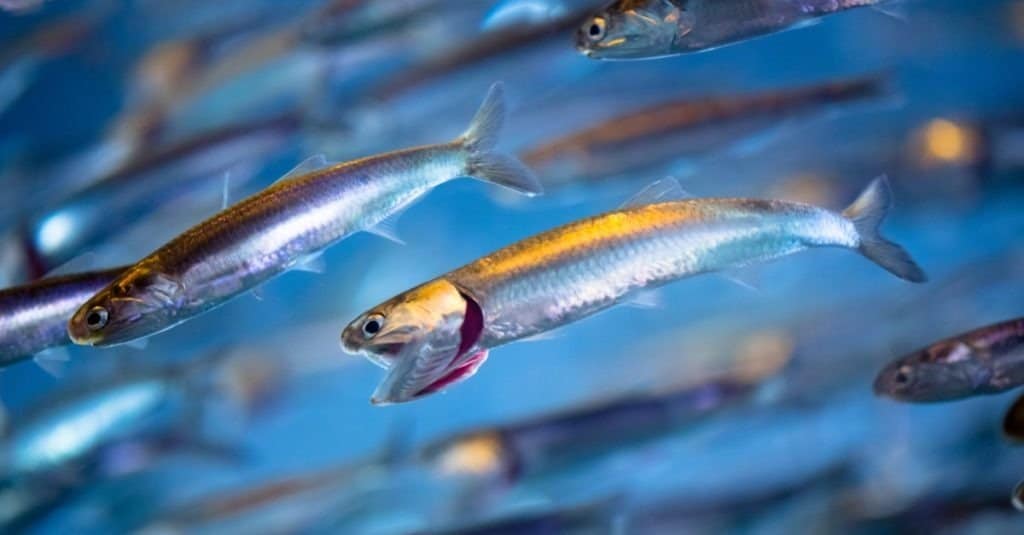
Anchovies are pretty similar to sardines, although they have a reddish color when prepared.
©evantravels/Shutterstock.com
Sardines and Anchovies may seem alike in many ways. Both are smaller fish that can be canned for consumption. They are both used heavily in cooking as a source of omega-3 fatty acids, vitamins, and minerals.
However, Sardines have a prominent lower jaw and white flesh when cooked or salted. In contrast. Anchovies have smaller mouths and are a reddish color when the smoked, salted or otherwise prepared.
5 Sardines Facts
- Named for the island of Sardinia in the Mediterranean where these fish were plentiful.
- More than 21 unique species of sardines are part of the herring family.
- Found all over the world from the North Atlantic and Pacific Oceans to the Mediterranean Sea, the Indian Ocean, and the waters around South America.
- Normally canned as food in olive oil, water, tomato juice, or other liquids.
- Excellent source of omega-3 fatty acids, which promote heart health.
Classification and Scientific Name
Sardines are a broadly defined name for several small herring fish. There are at least 21 different species across five different genera. These major groups include
- Sardina.
- Sardinops.
- Sardinella.
- Dussumieria
Evolution
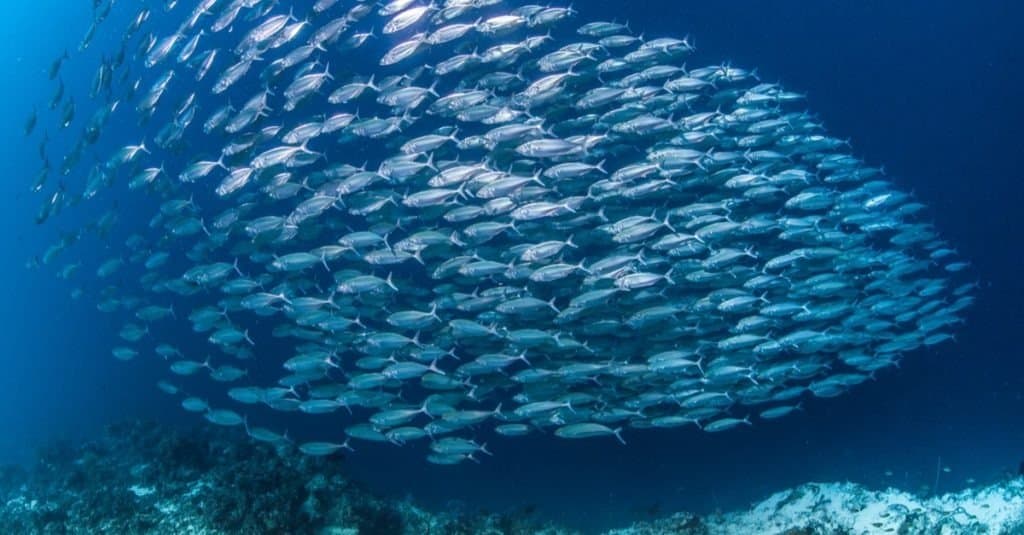
The earliest ancestors of sardines first emerged during the Late Jurassic period
©paul cowell/Shutterstock.com
Sardines are Clupeiformes a classification of fish which can be traced back to the Late Jurassic, a period which occurred between 145 – 200 million years ago. The group includes anchovies which belong to the Engraulidae family as well as the Clupeidae family. The latter group consists of herrings, sardines, and shads and dates back to the Paleogene era, i.e., between 23 – 66 million years ago.
Members of the Clupeidae family are noted for absent or reduced teeth, gleaming scales, the presence of a single dorsal fin in the majority of cases, as well as a love of plankton. They are also impressively prolific producers and occupy a rather low position on the food chain.
Species
There are over 21 different species of sardine fish throughout the world. Some of the most well-known are
- The European Pilchard, or Sardina pilchardus: Occasionally capable of growing to 11 inches, the European Pilchard can be found in the Atlantic, Black Sea, and the Mediterannean.
- The Freshwater Sardine (Sardinella tawilis): Endemic to the Phillipines, this fish which can be recognized by its triangular dorsal fin, is capable of growing to 6 inches. It is also known as the freshwater herring.
- The Rainbow Sardine (Dussumieria acuta): Mostly found in southeast Asia, this fish also known as the rainbow herring, is capable of growing to 8 inches.
- The South American Pilchard (Sardinops sagax): This species can grow up to 16 inches and is can be found in the Indo-Pacific and the eastern pacific.
- The White Sardine (Escualosa thoracata): Generally found in Thailand, Indonesia, and extending to Australia, this species is capable of growing to a maximum length of 4 inches.
Appearance
Quite a few herring fish are referred to as sardines when they are young juveniles. These fish are typically less than 12 inches long and have an elongated body with silvery scales. They typically have no scales on their heads and only one small dorsal fin on the top of their head.
Because more than 20 fish species are considered sardines, this fish’s weight can vary substantially. Some types weigh as little as two or three ounces while others are closer to six or seven pounds.
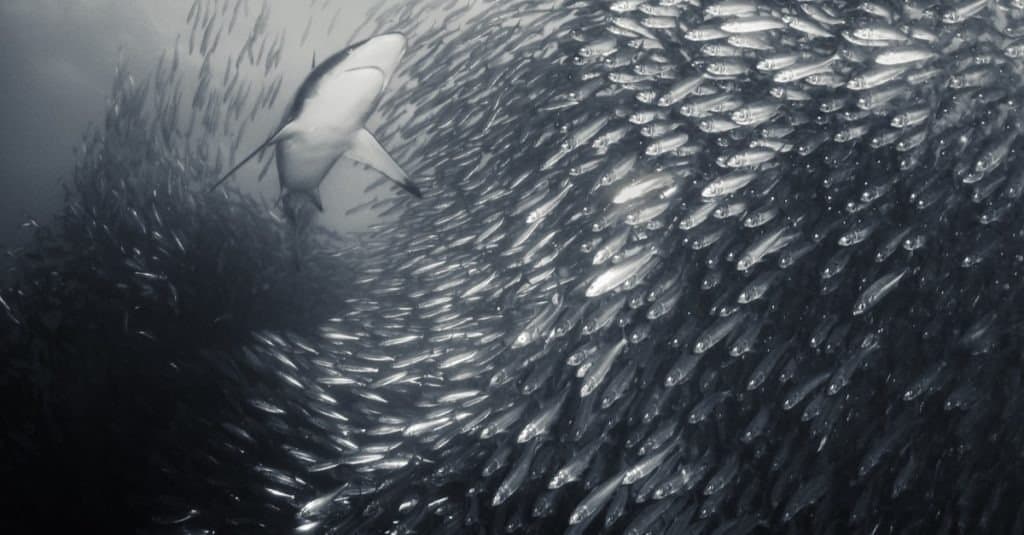
©wildestanimal/Shutterstock.com
Distribution, Population, and Habitat
The numerous species are found in saltwater oceans, seas, and other bodies of water throughout the world. Schools of these fish frequent the Atlantic Ocean and waters around California and Mexico. They are also common in South America, Europe, Africa, and Asia.
The exact numbers of each species are unknown. However, populations are stated in metric tons when trying to determine if these creatures are being overfished. For example, the Pacific Sardine’s population is currently estimated at more than 27 metric tons. While that may sound like a lot, the target level for this fish is 150 metric tons. As a result, the NOAA currently classifies the Pacific Sardine as overfished.
Predators
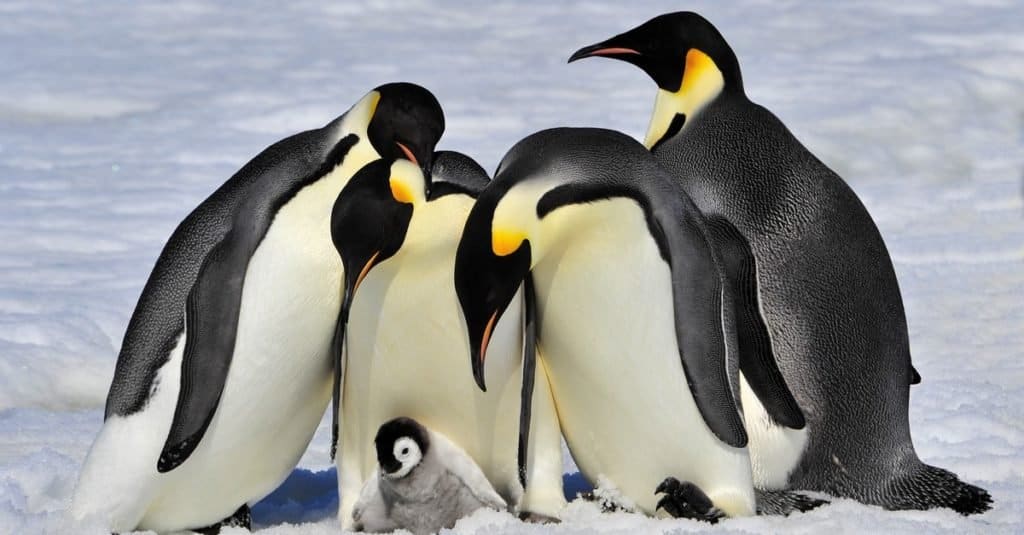
Penguins enjoy sardines which they consider to be a nourishing snack
©vladsilver/Shutterstock.com
Many marine animals and birds subsist on these fish as a key component of their nutrition. Dolphins, seals, and Blue Whales are examples of ocean mammals that eat these fish. Penguins, terns, Brown Pelicans, and other seafaring birds also love to scoop herrings out of the water for a snack.
Humans are also another significant predator to sardines. Because these fish only swim between 0 and 200 meters below the surface, our impact on their habitats is relatively minor compared to other sea life. However, they are highly sought after in Europe, Asia, and India as a source of nutrition. Overfishing and commercialization is a major risk to the worldwide sardine population.
Diet

Sardines typically eat zooplankton and phytoplankton, which are microscopic organisms found in the Earth’s oceans. Plankton can include the small eggs of larger fish species as well as tiny crustaceans and other creatures that cannot swim along the ocean currents.
Reproduction and Lifespan
These fish can spawn as early as one to two years of age. Females can have between 10,000 and 40,000 eggs available for fertilization. Initially, scientists believed that sardines spawned only once or twice per season, but recent studies indicate that it may be much more frequent.
Fishing and Cooking
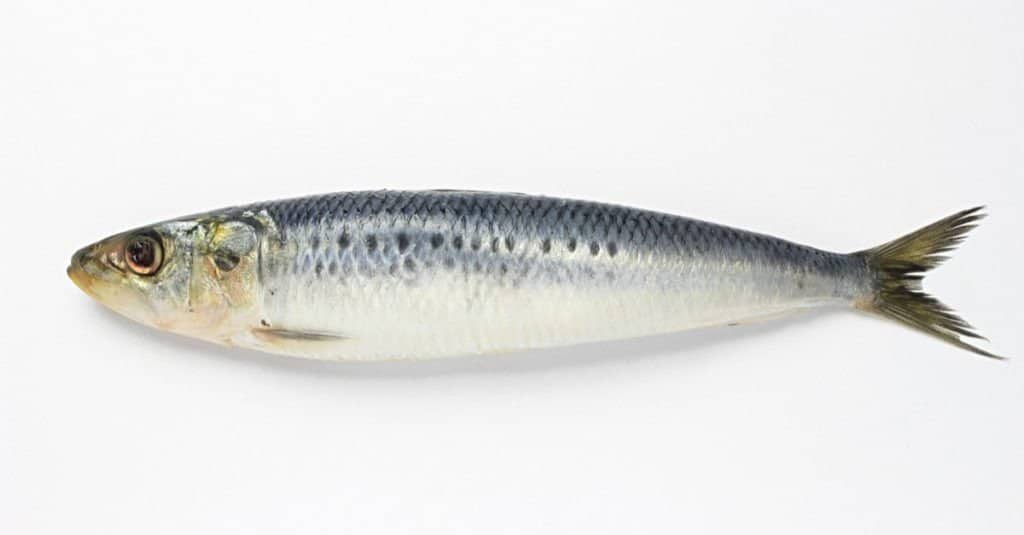
Sardines are widely eaten all around the globe
©flyingv3/Shutterstock.com
Sardines are a common source of nutrition around the world. In fact, over the last decade, commercial fishing has caught more than three million tons of these fish annually.
These fish are frequently canned in olive oil. The oil helps the meat remain moist and tender and keeps its rich flavor. Cheaper sardines can be kept in tin cans filled with water, tomato juice, or other liquids. However, these approaches result in the meat sometimes being soggy or slimy.
The fish can also be smoked or salted to preserve their dense white flesh. Many people choose to eat them straight out of the can on crackers with tomatoes or onions.
Population
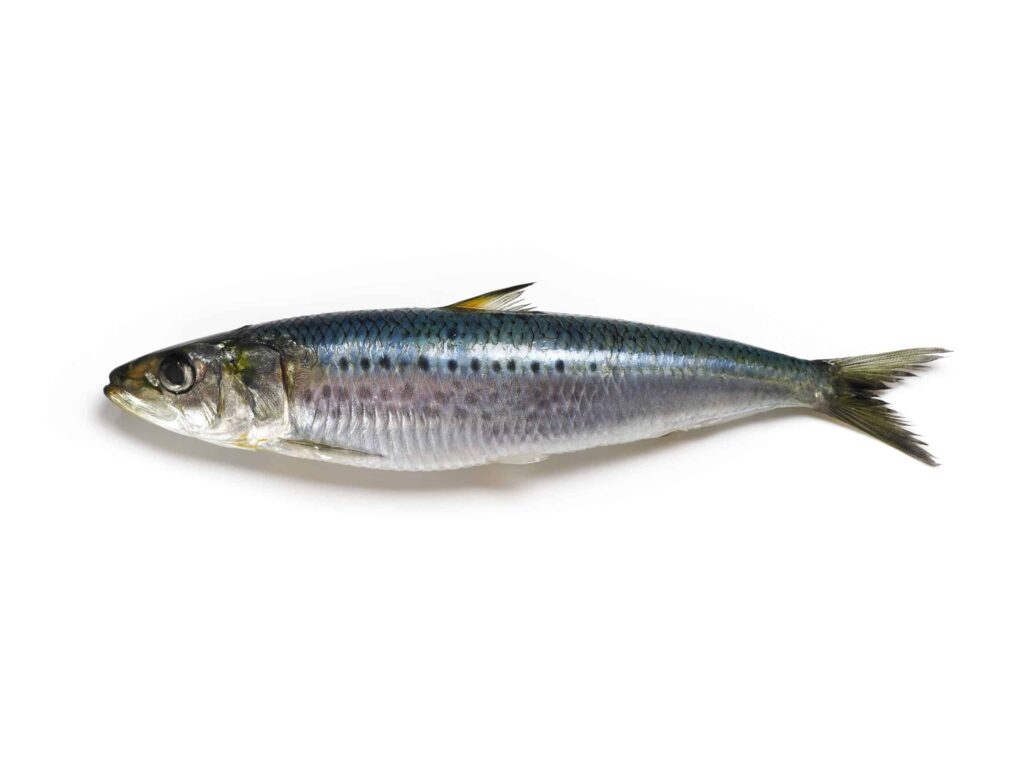
Pacific sardines are believed to have a population which is equivalent in weight to 27 metric tons
©optimarc/Shutterstock.com
Estimating the worldwide population of sardines is challenging because of the diverse regions where they live. The large number of species included in the pilchard or herring family also makes a numerical count difficult. Instead, sardine populations are often measured in metric tons.
For example, Pacific sardines, which are one of the most popular options for canning, salting, and cooking, have an estimated population of more than 27 metric tons.
List of Sardine Species
- European pilchard
- Freshwater sardine
- Goldstripe sardinella
- Indian oil sardine
- Marquesan sardinella
- Rainbow sardine
- Round sardinella
- White sardine
- Slender rainbow sardine
- Slender white sardine
- South American pilchard
Sardines FAQs (Frequently Asked Questions)
Sardines vs Anchovies
Sardines and anchovies are commonly associated since both are small fish that are used in cooking. While the two fish are of similar size and may look alike, they do have some key differences. For example, while sardines have more of a light and buttery flavor, anchovies have a powerfully salty flavor.
What are sardines?
Sardines also called pilchards in Europe, are one of any number of fish that are part of the herring family. In fact, there are five different genera that include more than 16 distinct species of sardines. As a result, these vertebrates are found all over the world from the North Atlantic to South America, Asia, and India.
They are generally small, but lengthy fish that measure between six and 12 inches long. However, some species, such as the South American pilchard can reach more than 15 inches long. They usually have one dorsal fin and a silvery color with blue eyes.
What's the difference between sardines vs anchovies?
On the surface, Sardines and Anchovies appear to be similar. They are both small fish that are used heavily in cooking for their nutritional value. However, Sardines have a more noticeable lower jaw than anchovies. Anchovy flesh is also a reddish color when the meat is smoked, salted, or cured. Sardine flesh is white.
What do sardines taste like?
Sardines have dense and oily meat-like flavor no matter if they are cooked, salted or smoked. Fresh sardines can have a strong fishy taste. However, if you cook the fish just until it starts to flake, then sardines have a very mild, pleasant flavor.
Are canned sardines good for you?
Yes! Sardines naturally contain omega-3 fatty acids, like Salmon. In fact, they have some of the highest concentration of this heart-healthy nutrient of any fish. Best of all, the amount of mercury in sardines is low because they primarily eat zooplankton and phytoplankton. Per the Cleveland Clinic, they are even safe for pregnant women to eat.
These fish are also a natural source of Vitamin D and Calcium. Calcium is critical for bone strength while Vitamin D helps to control the calcium and phosphate level in your body.
Despite their benefits, moderation is important with sardines. The smoked and salted varieties can be high in sodium content, which can negatively impact your blood pressure levels or have other negative effects.
Do sardines have poop in them?
Yes, sardines are normally salted and canned whole in olive oil. As a result, all of their vital organs, including the intestines, remain intact when you eat them. They are typically not filleted whether you buy them canned, smoked, or frozen raw, which means that there is likely some poop left in each fish.
What do Sardiness eat?
Sardines are Omnivores, meaning they eat
What Kingdom do Sardines belong to?
Sardines belong to the Kingdom Animalia.
What phylum do Sardines belong to?
Sardines belong to phylum Chordata.
What class do Sardines belong to?
Sardines belong to the class Actinopterygii.
What family do Sardines belong to?
Sardines belong to the family Clupeidae.
What order to Sardines belong to?
Sardines belong to order Clupeiformes.
What type of covering do Sardines have?
Sardines are covered in Scales.
In what type of habitat do Sardines live?
Sardines live in saltwater oceans and seas around the world.
What is the main prey for Sardines?
Sardines prey on zooplankton and phytoplankton.
What are some predators of Sardines?
Predators of Sardines include dolphins, seals, penguins, sharks, terns, and pelicans.
What is the lifespan of a Sardine?
Sardines can live for up to 13 years.
How many species of Sardines are there?
There are 21 species of Sardines.
What is a distinguishing feature of the Sardines?
Sardines are silver in color and have one small dorsal fin.
What is the biggest threat to the Sardine?
The Sardine is also called the pilchard or sardina.
How do Sardines have babies?
Sardines lay eggs.
What is the difference between sardine and tuna?
The greatest differences between sardines and tuna include their size and families. Sardines are small fish from five different genera that only reach about 12 inches and 4.5 pounds at their largest, but tuna can weigh anywhere from 3 pounds to 1,500 pounds and measure up to 15 feet long. Tuna also come from five different genera, but they do not share any of the same families as sardines. These massive differences make it easy to tell these creatures apart. We’re going to dig deep into five differences between them to show you just how unique these fish are despite both being popular foods for people.
What are the key differences between herring and sardines?
The greatest differences between herring and sardines can be found in their potential size and phylogenetic families. Fish considered sardines are often heavier than herring, weighing between 0.2 and 4.5 pounds compared to the herring, which tops out at 2.2 pounds.
What are the key differences between kippers and sardines?
The greatest differences between kippers and sardines can be found in their phylogenetic families and the way they’re served as food. Kippers are herring, and they are mainly from the Clupeidae family, specifically the genus Clupea. Sardines are also from the family Clupeidae, but they stem from other genera including Sardina, Sardinops, and Sardinella.
Thank you for reading! Have some feedback for us? Contact the AZ Animals editorial team.
Sources
- Wikipedia, Available here: https://en.wikipedia.org/wiki/Sardine
- Animal Diversity Web, Available here: https://animaldiversity.org/accounts/Sardina_pilchardus/classification/
- Food & wine, Available here: https://www.foodandwine.com/seafood/fish/difference-between-sardines-and-anchovies
- Health Essentials, Available here: https://health.clevelandclinic.org/3-fish-you-should-love-and-3-fish-you-should-snub/
- Fishbase, Available here: https://www.fishbase.se/summary/Sardinops-sagax.html
- STATUS OF THE PACIFIC COAST COASTAL PELAGIC SPECIES FISHERY AND RECOMMENDED ACCEPTABLE BIOLOGICAL CATCHES, Available here: chrome-extension://ohfgljdgelakfkefopgklcohadegdpjf/https://www.pcouncil.org/documents/2020/10/2019-cps-safe-june-2020.pdf/
- Tin Can fish, Available here: https://tincanfish.com/blogs/pedros-peixe/environmental-and-health-benefits-of-sardines#:~:text=One%20type%20of%20fish%2C%20sardines,is%20roughly%20seven%20billion%20pounds.

